An Algorithm for Solving the Problem of Phase Unwrapping in Remote Sensing Radars and Its Implementation on Multicore Processors
Abstract
1. Introduction
- The topographic phase due to the terrain;
- The phase caused by a change in the inclined range due to the displacement of the surface element between shots;
- Phase noise caused by a partial loss of coherence of reflected waves due to differences in shooting angles and surface variability during the time between shots during two-pass shooting (spatial and temporal decorrelation).
2. Source Data for the Problem
3. Numerical Method for Problem Solving
- (0)
- Initialization of input data and parameters: interferogram and frequency response of the filter .
- (1)
- Detection of singular points (calculation of the interferogram residue function using Formula (4) and counting their number . If , then go to step 6.
- (2)
- Calculation of the inverse vortex field by the Formula (5).
- (3)
- Filtering of the field , obtaining a smoothed inverse vortex field using the Formula (10).
- (4)
- Calculation of the number of singular points of the smoothed inverse vortex field . If , then we accept the inverse vortex field equal to the smoothed . Otherwise, we return to step 0 with the input arguments , .
- (5)
- (6)
- Calculation of the unwrapped interferogram according to Formula (9).
4. Parallel Implementation of the Numerical Algorithm
- The entire interferogram of size pixels is divided into blocks B of small size pixels. The optimal block size is selected experimentally. On the one hand, the block and auxiliary data must fit entirely into the system’s RAM. On the other hand, increasing the number of blocks should not significantly slow down calculations.
- In each j-th block, the fragment of an elementary vortex of size is calculated, the break point of which is located in the upper left corner of the i-th block, and the boundaries cover the j-th block. When calculating the inverse vortex field in the j-th block from the singular point k with coordinates lying in the i block, a fragment of the elementary vortex of the size of shifted by relative to the upper-left corner is read. The contents of the read fragment are added to the previously calculated inverse vortex field.
- Step 3 is repeated until all singular points in block have been passed.
- Steps 3–4 are repeated until all pairs of blocks have been processed.
- The inverse vortex fields of size , calculated in all blocks , are joined into a united inverse vortex field of size .
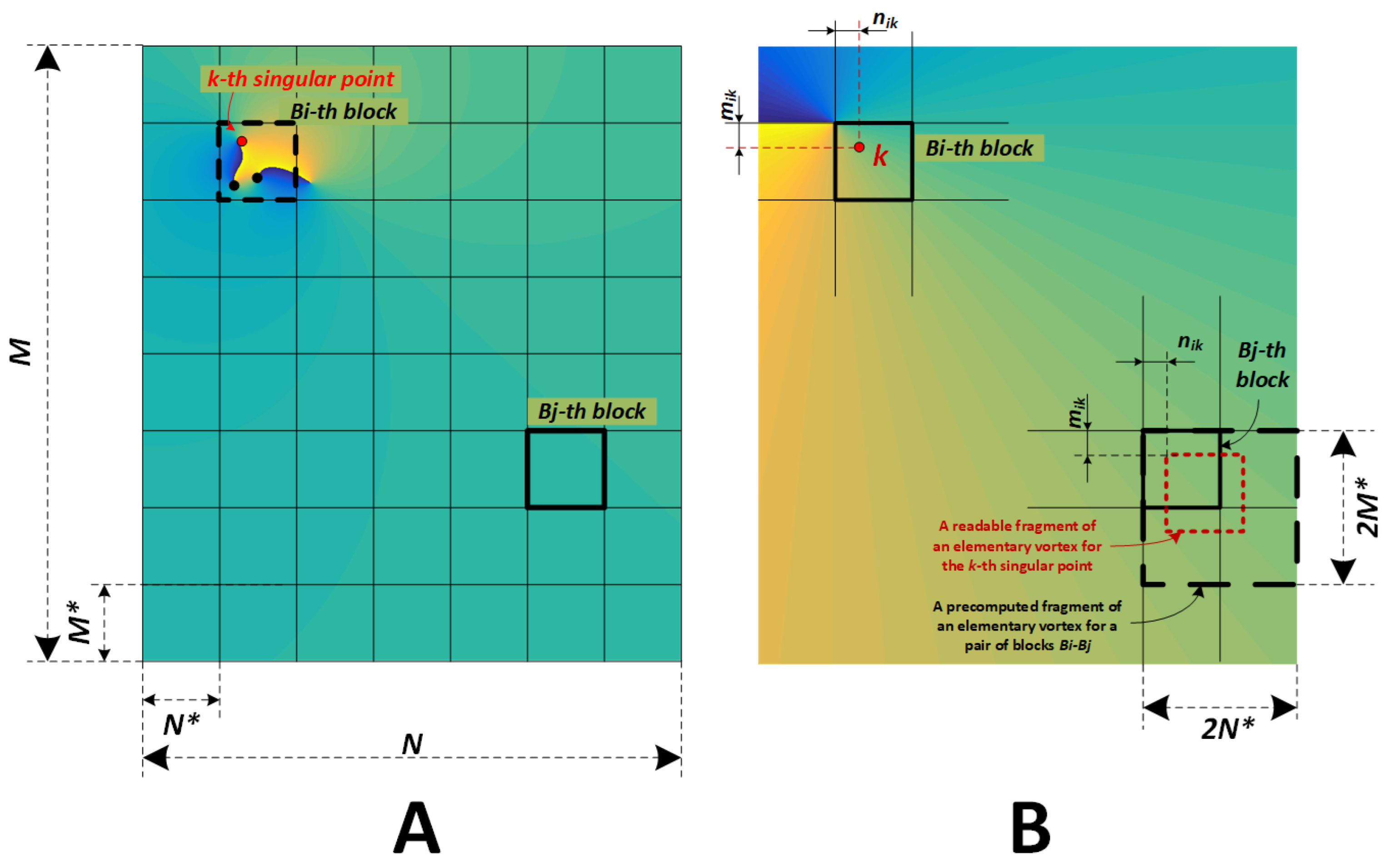
5. Numerical Experiments for Interferogram Models and OpenMP Performance
Data Models
6. Conclusions
Author Contributions
Funding
Data Availability Statement
Acknowledgments
Conflicts of Interest
Abbreviations
| InSAR | Interferometric Synthetic Aperture Radar |
| IVPF | Inverse Vortex Phase Field Flattening algorithm |
| RMSE | Root Mean Square Error |
| SAR | Synthesized Aperture Radars |
References
- Hanssen, R.F. Radar Interferometry. Data Interpretation and Error Analysis; Kluwer Academic Publishers: Dordrecht, Germany, 2002; pp. 81–113. [Google Scholar]
- Verba, V.S.; Neronskiy, L.B.; Osipov, I.G.; Turuk, V.E. Space-Borne Earth Surveillance Radar Systems. Moscow: Radio Engineering; Radiotechnika: Moscow, Russia, 2010; pp. 475–485. [Google Scholar]
- Zhang, T.; Zhang, X.; Li, J.; Xu, X.; Wang, B.; Zhan, X.; Xu, Y.; Ke, X.; Zeng, T.; Su, H.; et al. SAR Ship Detection Dataset (SSDD): Official Release and Comprehensive Data Analysis. Remote Sens. 2021, 13, 3690. [Google Scholar] [CrossRef]
- Rosen, P.A.; Hensley, S.; Joughin, I.R.; Li, F.K.; Madsen, S.N.; Rodriguez, E.; Goldstein, R.M. Synthetic Aperture Radar Interferometry. IEEE Proc. 2000, 88, 33–82. [Google Scholar] [CrossRef]
- Constantini, M. A novel phase unwrapping method based on network programming. IEEE Trans. Geosci. Remote Sens. 1998, 36, 813–821. [Google Scholar] [CrossRef]
- Chen, C.W.; Zebker, H.A. Network approaches to two-dimensional phase unwrapping: Intractability and two new algorithms. J. Opt. Soc. Am. A Opt. Image Sci. Vis. 2000, 17, 401–414. [Google Scholar] [CrossRef]
- Wang, K.; Kemao, Q.; Di, J.; Zhao, J. Deep learning spatial phase unwrapping: A comparative review. Adv. Photonics Nexus 2022, 1, 014001. [Google Scholar] [CrossRef]
- Li, L.; Zhang, H.; Tang, Y.; Wang, C.; Gu, F. InSAR Phase Unwrapping by Deep Learning Based on Gradient Information Fusion. IEEE Geosci. Remote Sens. Lett. 2022, 19, 4502305. [Google Scholar]
- Wu, C.; Qiao, Z.; Zhang, N.; Li, X.; Fan, J.; Song, H.; Ai, D.; Yang, J.; Huang, Y. Phase unwrapping based on a residual en-decoder network for phase images in Fourier domain Doppler optical coherence tomography. Biomed. Opt. Express 2020, 11, 1760–1771. [Google Scholar] [CrossRef] [PubMed]
- Wang, K.; Li, Y.; Kemao, Q.; Di, J.; Zhao, J. One-step robust deep learning phase unwrapping. Opt. Express 2019, 27, 15100–15115. [Google Scholar] [CrossRef] [PubMed]
- Yu, H.; Lan, Y.; Yuan, Z.; Xu, J.; Lee, H. Phase Unwrapping in InSAR. A review. IEEE Geosci. Remote Sens. Mag. 2019, 7, 40–58. [Google Scholar] [CrossRef]
- Gao, J.; Jiang, H.; Sun, Z.; Wang, R.; Han, Y. A Parallel InSAR Phase Unwrapping Method Based on Separated Continuous Regions. Remote Sens. 2023, 15, 1370. [Google Scholar] [CrossRef]
- Aoki, T.; Sotomaru, T.; Ozawa, T.; Komiyama, T.; Miyamoto, Y.; Takeda, M. Two-dimensional phase unwrapping by direct elimination of rotational vector fields from phase gradients obtained by heterodyne techniques. Opt. Rev. 1998, 5, 374–379. [Google Scholar] [CrossRef]
- Tomioka, S.; Heshmat, S.; Miyamoto, N.; Nishiyama, S. Phase unwrapping for noisy phase maps using rotational compensator with virtual singular points. Appl. Opt. 2010, 49, 4735–4745. [Google Scholar] [CrossRef]
- Heshmat, S.; Tomioka, S.; Nishiyama, S. Performance Evaluation of Phase Unwrapping Algorithms for Noisy Phase Measurements. Int. J. Optomechatronics 2014, 8, 260–274. [Google Scholar] [CrossRef]
- Sosnovsky, A.V.; Kobernichenko, V.G. An InSAR phase unwrapping algorithm with the phase discontinuity compensation. CEUR Workshop Proc. 2017, 2005, 127–136. [Google Scholar]
- Sosnovsky, A.V.; Kobernichenko, V.G. Processing of large-size InSAR images: Parallel implementation of inverse vortex phase field algorithm. CEUR Workshop Proc. 2018, 2274, 75–81. [Google Scholar]

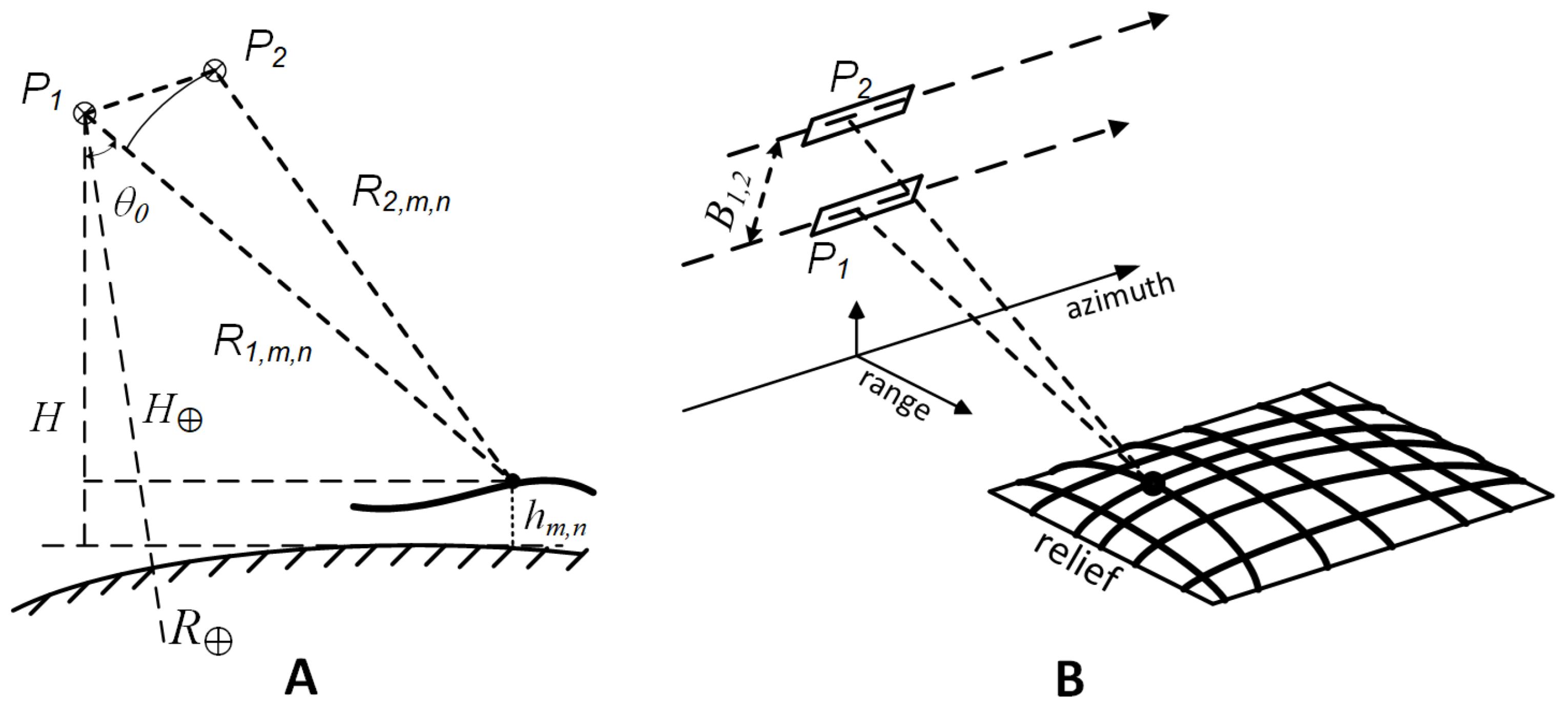
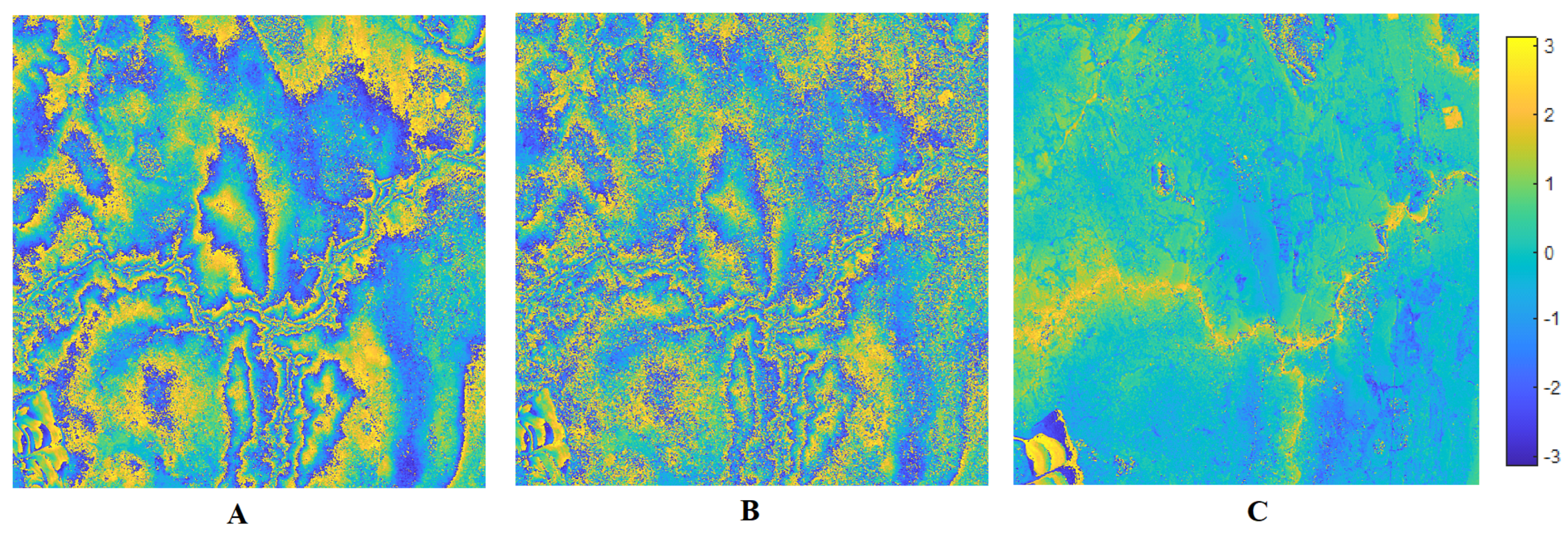
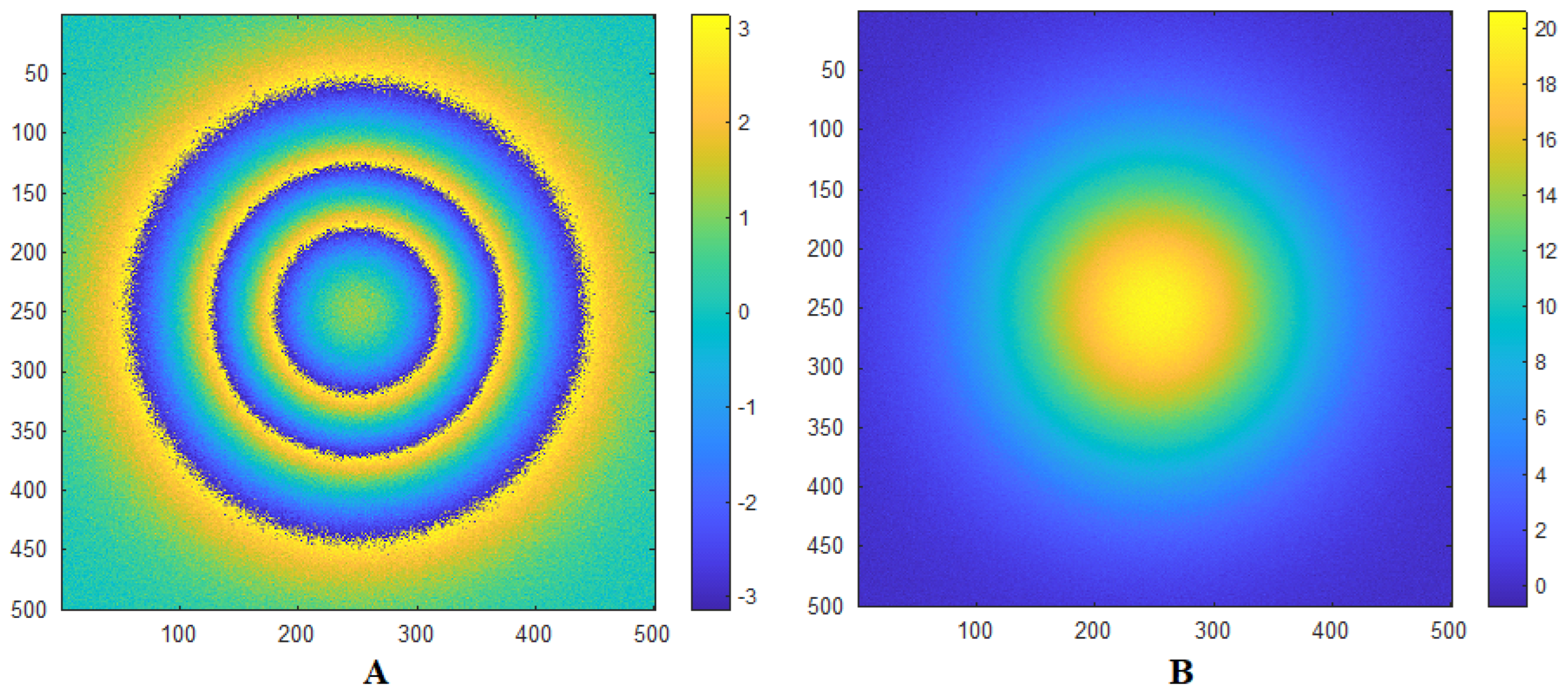


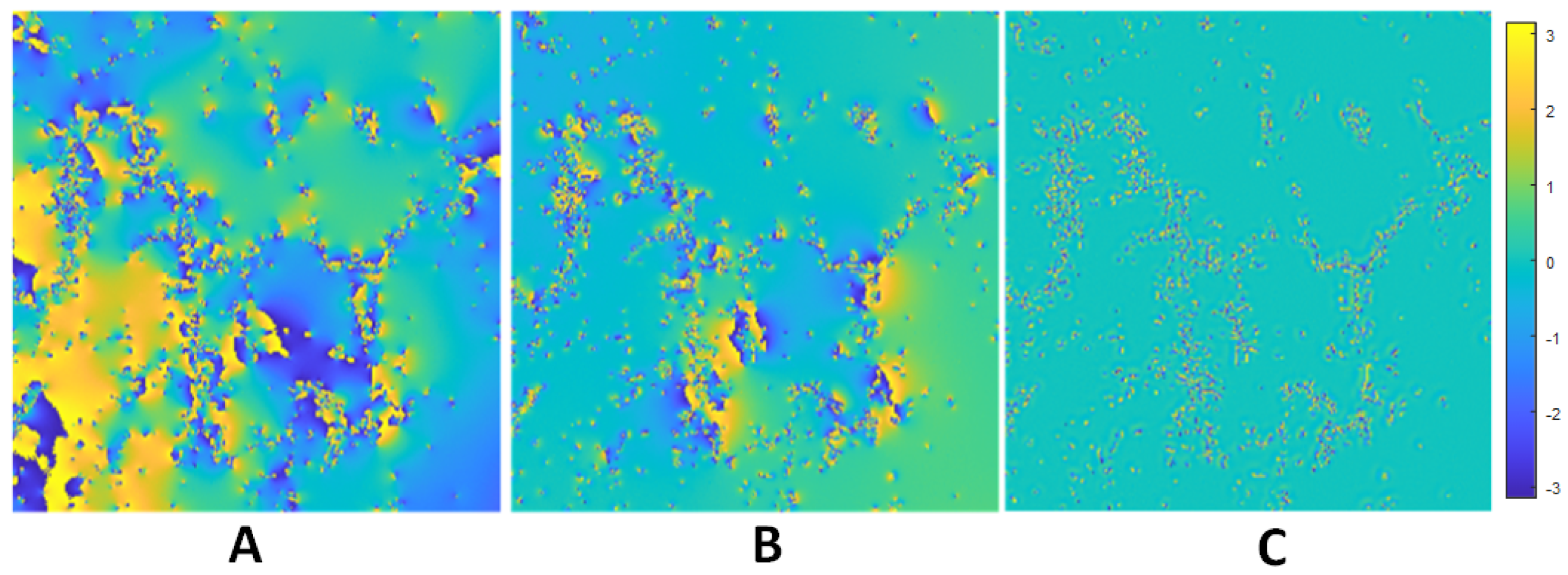

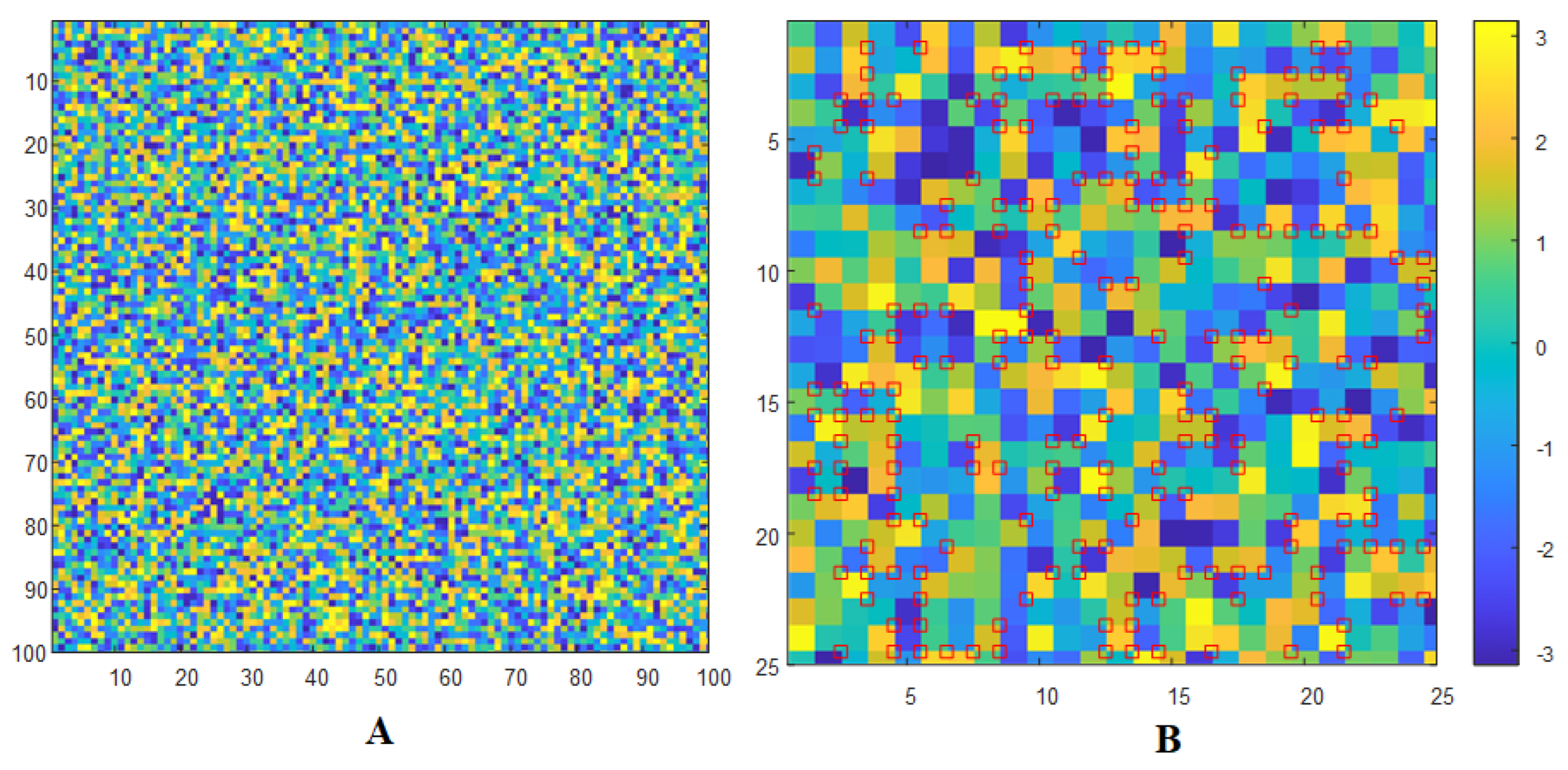
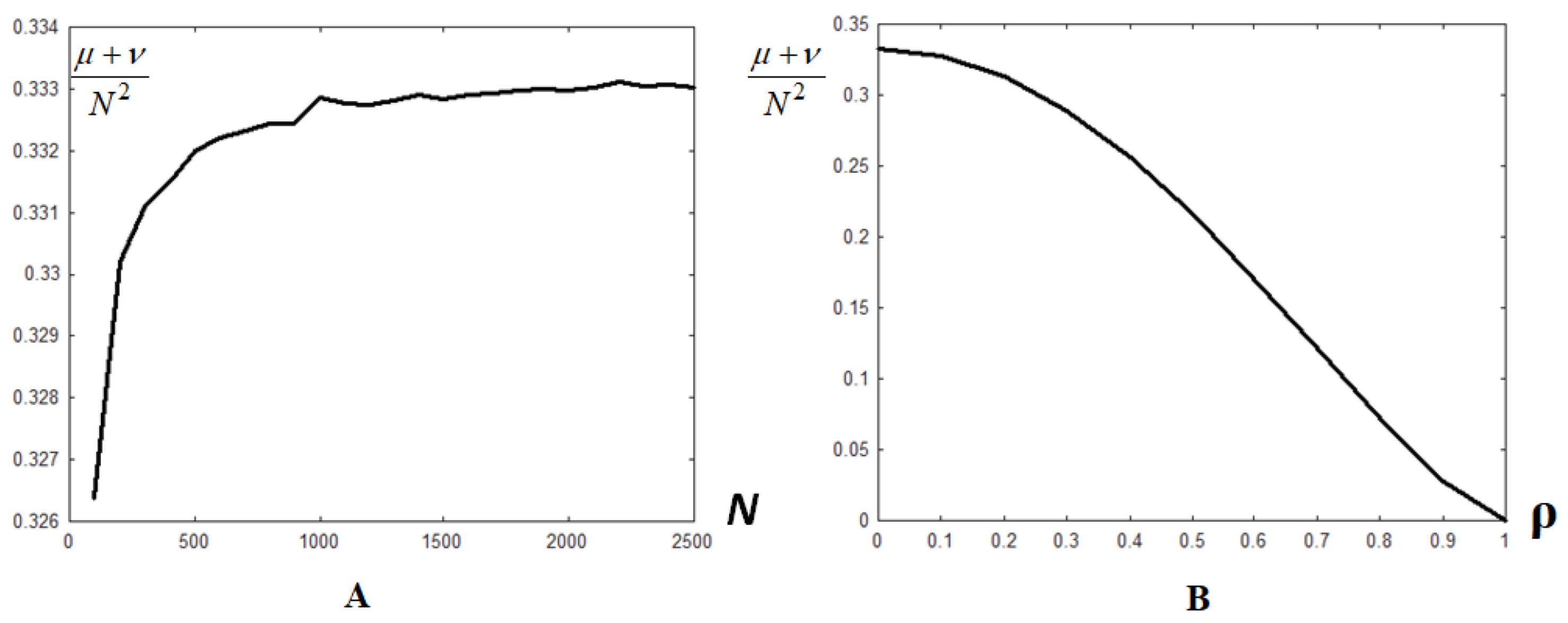
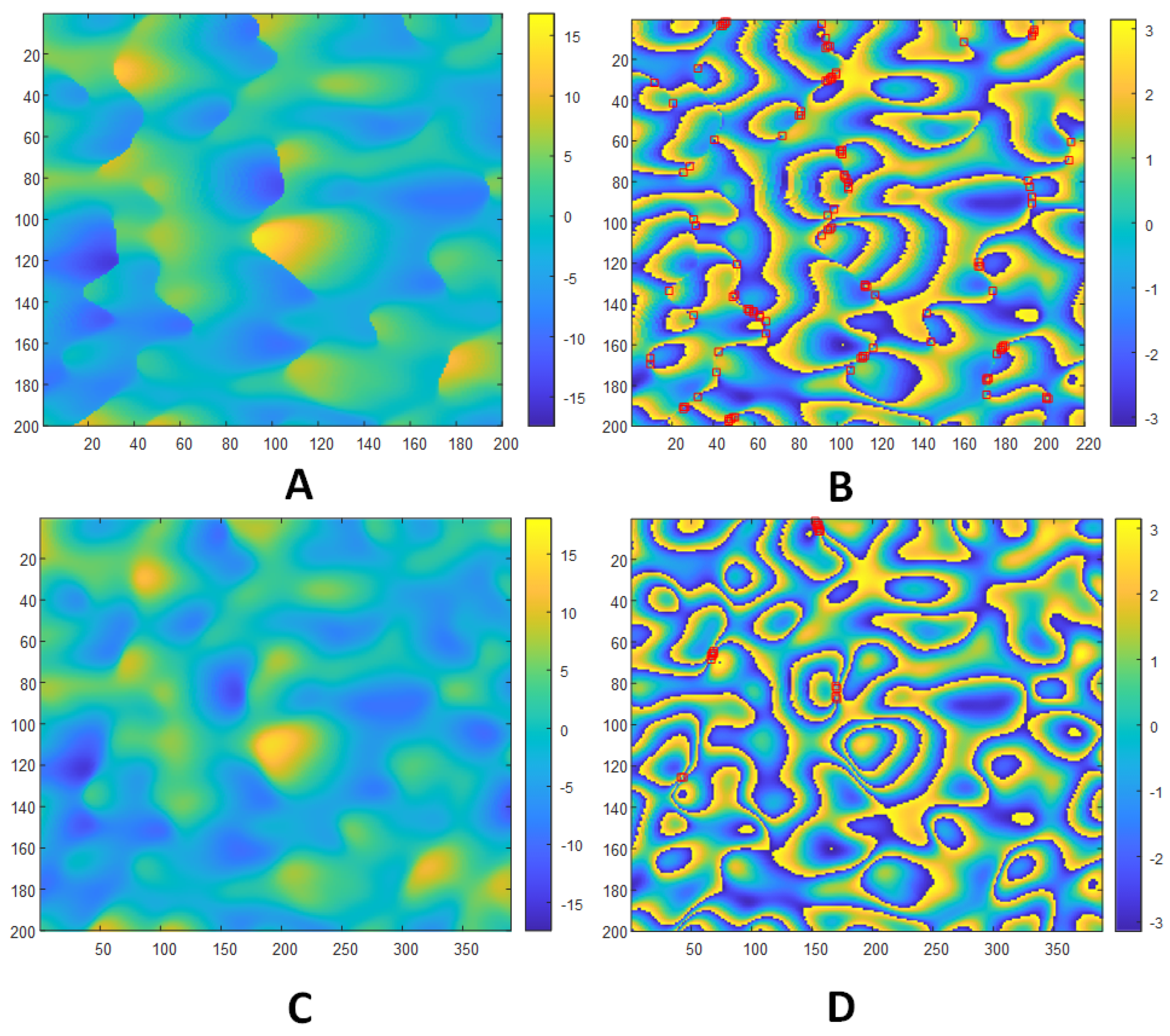
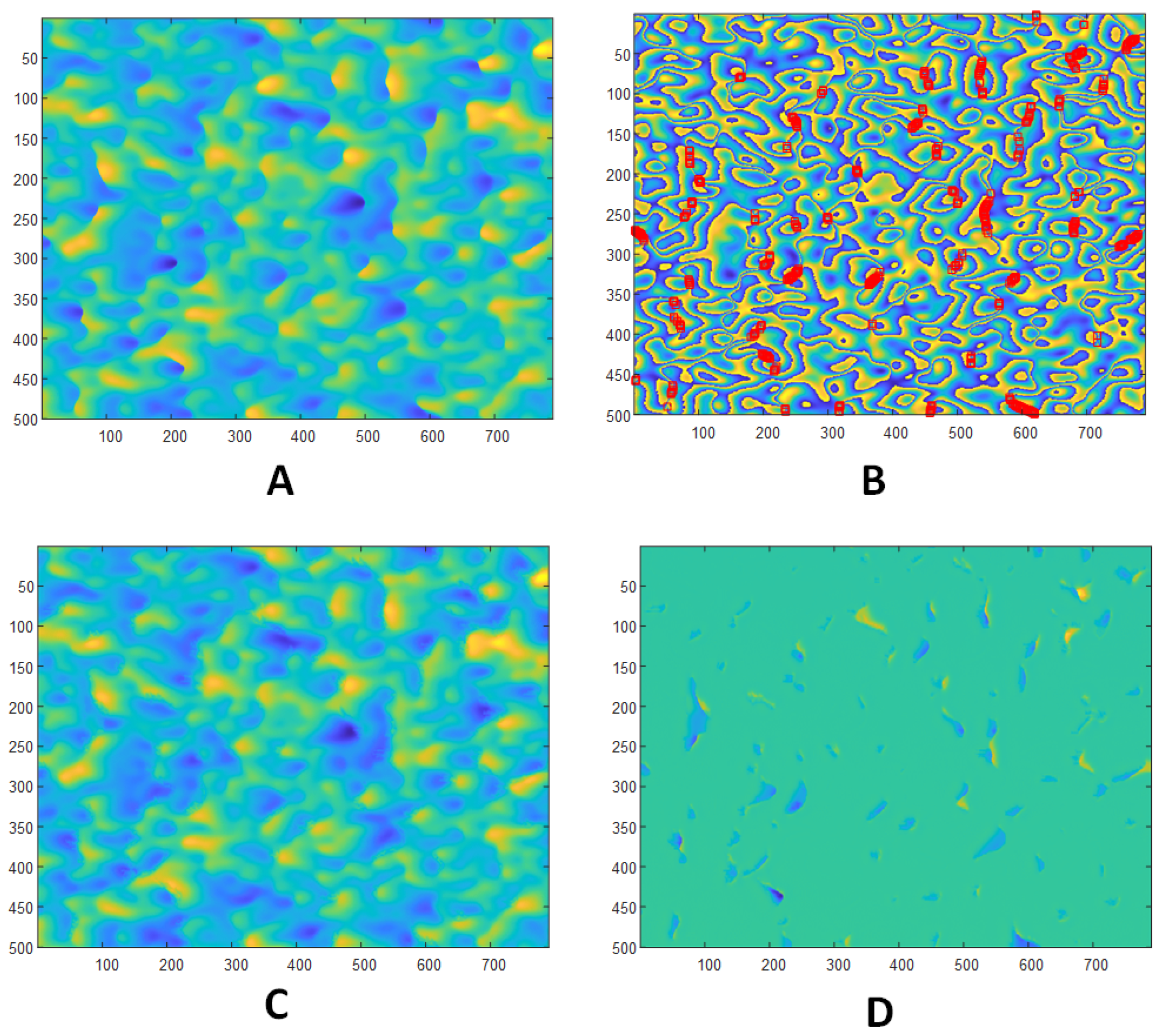
| Number m of OpenMP Threads | Time [min.] | Speedup | Efficiency |
|---|---|---|---|
| 1 | 59.8 | — | — |
| 2 | 29.9 | 2.00 | 1.00 |
| 6 | 16.0 | 3.75 | 0.62 |
| 12 | 10.7 | 5.60 | 0.47 |
| Interferogram Number | Number m of OpenMP Threads | Time [min] | Speedup | Acurracy [Radians] |
|---|---|---|---|---|
| 1 | 1 | 13.8 | — | 1.27 |
| () | 12 | 2.7 | 5.1 | 1.27 |
| 2 | 1 | 64.3 | — | 1.22 |
| () | 12 | 12.6 | 5.1 | 1.22 |
| 3 | 1 | 298 | — | 1.19 |
| () | 12 | 53.3 | 5.6 | 1.19 |
Disclaimer/Publisher’s Note: The statements, opinions and data contained in all publications are solely those of the individual author(s) and contributor(s) and not of MDPI and/or the editor(s). MDPI and/or the editor(s) disclaim responsibility for any injury to people or property resulting from any ideas, methods, instructions or products referred to in the content. |
© 2024 by the authors. Licensee MDPI, Basel, Switzerland. This article is an open access article distributed under the terms and conditions of the Creative Commons Attribution (CC BY) license (https://creativecommons.org/licenses/by/4.0/).
Share and Cite
Martyshko, P.S.; Akimova, E.N.; Sosnovsky, A.V.; Kobernichenko, V.G. An Algorithm for Solving the Problem of Phase Unwrapping in Remote Sensing Radars and Its Implementation on Multicore Processors. Mathematics 2024, 12, 727. https://doi.org/10.3390/math12050727
Martyshko PS, Akimova EN, Sosnovsky AV, Kobernichenko VG. An Algorithm for Solving the Problem of Phase Unwrapping in Remote Sensing Radars and Its Implementation on Multicore Processors. Mathematics. 2024; 12(5):727. https://doi.org/10.3390/math12050727
Chicago/Turabian StyleMartyshko, Petr S., Elena N. Akimova, Andrey V. Sosnovsky, and Victor G. Kobernichenko. 2024. "An Algorithm for Solving the Problem of Phase Unwrapping in Remote Sensing Radars and Its Implementation on Multicore Processors" Mathematics 12, no. 5: 727. https://doi.org/10.3390/math12050727
APA StyleMartyshko, P. S., Akimova, E. N., Sosnovsky, A. V., & Kobernichenko, V. G. (2024). An Algorithm for Solving the Problem of Phase Unwrapping in Remote Sensing Radars and Its Implementation on Multicore Processors. Mathematics, 12(5), 727. https://doi.org/10.3390/math12050727







